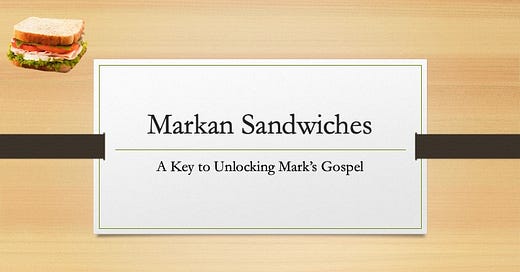INTRODUCTION TO MARKAN SANDWICHES
Let me start by sharing two personal stories that form the experiential background to this book.
First, in 1981, I was sitting in the living room of my grandfather’s mobile home in Mims, Florida. My grandfather having experienced a fresh awakening to his faith, he and I were discussing the Bible for the first time ever. Specifically, we were discussing Mark’s story of the cursing of the fig tree in chapter 11. My grandfather said, “I don’t understand that story.”
It is a confusing story. It takes place right after Jesus rode into Jerusalem in the event we commemorate as Palm Sunday. The next day, as he approaches Jerusalem again, Jesus is hungry. He finds a fig tree and approaches it to pick some figs to eat. But there were no figs. The tree was all leaf and no fruit. So, Jesus curses the fig tree. Later, the tree is found to have withered away to its roots. Mark adds the strange detail, “it was not the season for figs.” This was what confused my grandfather. “Why did Jesus curse the poor ole fig tree when it wasn’t even the season for producing figs!? Sure makes Jesus look bad,” my grandfather concluded. “I don’t get it.”
That visit to Florida was long before I ever studied Mark’s gospel in seminary, and long before I ever heard about Markan sandwiches. Now that I have, I would love to have that conversation with my now departed grandfather again. I believe I could help clear up his confusion!
The second story involves a course I took in seminary with Dr. John Holbert called “Narrative Preaching.” As part of that course, Dr. Holbert had me read Robert Alter’s book The Art of Biblical Narrative. Dr. Alter showed me that the Bible communicates not only by what it says, but also by how it says it. The biblical writers were inspired to use what we would call literary techniques such as plot development, characterization, and structure to help communicate their message. That was a life-changing insight for me which shaped much of how I would subsequently preach and teach the Bible throughout my 30+ year ministry.
Robert Alter is a Hebrew scholar and the Bible he refers to in his book is the Hebrew Bible. But in my last year of seminary, I took a course on the Gospel According to Mark with Dr. C. Clifton Black. He introduced me to an article by James R. Edwards in the journal Novum Testamum (vol. XXXI) entitled, “Markan Sandwich: The Significance of Interpolations in Markan Narratives” which was published in 1989. In that article, I learned that even in the New Testament, particularly the gospels, the Bible communicates not only by what it says, but also by how it says it. In other words, literary art is as important as didactic content in communicating the message of the Bible.
Markan sandwiches are a literary technique Mark uses to make theological points. I go into more detail in the first chapter, but basically, Mark arranges his stories about Jesus in an A - B - A’ sequence, or what I call “bread” - “meat” - “bread” order. Thus, the name “sandwich”. The important thing is the “meat” stories interpret the “bread” and vice versa. By interpreting each other, like the fig tree story -- which is a “bread” story sandwiched around a temple story -- the stories communicate a truth that we often completely miss if we don’t recognize the linkage or know how to interpret the Markan sandwich.
James R. Edwards identifies nine Markan sandwiches. I identify two more, which are larger, multi-chapter sandwiches that I called Markan submarine sandwiches (or hoagies, grinders, heroes, po’ boys, or whatever name you know these delicious sandwiches by in your neck of the woods). In this book, we will look at three of the Markan sandwiches identified by Edwards and the two larger ones I identify. That leaves six to explore another time.
As I’ll attempt to show, Markan sandwiches are crucial to our understanding Mark’s gospel. They can help clear up some confusion we have when we read Mark. One of the Markan submarine sandwiches we will study is critical to our discipleship because it deals with Jesus as Messiah. If we don’t clearly understand what kind of Messiah Jesus is, we will be confused about what it means to be his follower. Mark, using this Markan sandwich technique, clarifies that for us. The other Markan sub sandwich clarifies God’s love for ALL people, Jew and Gentile alike, which is a major theme of The Genesis Project.
I hope this series will add not only to your understanding of the Gospel According to Mark, but also help you be a more faithful disciple.




